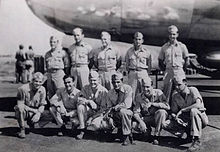USS Spearfish

| |
| History | |
|---|---|
| Builder | Electric Boat Company, Groton, Connecticut[1] |
| Laid down | 9 September 1937[1] |
| Launched | 29 October 1938[1] |
| Commissioned | 19 July 1939[1] |
| Decommissioned | 22 June 1946[1] |
| Stricken | 19 July 1946[1] |
| Fate | Sold for scrap, 19 May 1947[1] |
| General characteristics | |
| Class and type | |
| Displacement | |
| Length | 310 ft 6 in (94.64 m)[2] |
| Beam | 26 ft 10 in (8.18 m)[2] |
| Draft | 16 ft 7+1⁄2 in (5.067 m)[2] |
| Propulsion |
|
| Speed | |
| Range | 11,000 nautical miles (20,000 km) at 10 knots (19 km/h)[2] |
| Endurance | 48 hours at 2 knots (3.7 km/h) submerged[2] |
| Test depth | 250 ft (76 m)[2] |
| Complement | 5 officers, 54 enlisted[2] |
| Armament |
|
USS Spearfish (SS-190), a
Construction and commissioning
Spearfish′s
Pre-World War II service
Spearfish conducted sea trials off
First and second war patrols
Spearfish operated between
On 7 February, she began her second war patrol. Spearfish patrolled in the
Third-sixth war patrols
Her third war patrol, from 27 March to 20 May, took her to the Sulu Sea and Lingayen Gulf. On 17 April, she sank an enemy cargo ship of about 4,000 tons, and on 25 April, she sank Toba Maru, a 6,995-ton freighter.
On the night of 3 May, the submarine slipped into Manila Bay and picked up 14 nurses, and several staff officers from Corregidor.[5] She was the last American submarine to visit that beleaguered fortress before it surrendered. Navy nurse and Legion of Merit recipient Ann A. Bernatitus was among the 27 rescued by Spearfish.
From 26 June to 17 August, she scouted the South China Sea for enemy shipping, and from 8 September to 11 November, searched the west coast of Luzon, where she damaged two freighters.
Spearfish sailed from Brisbane on 2 December 1942 and patrolled in the New Britain-New Ireland area for over a month before entering Pearl Harbor on 25 January 1943. From Oahu, she was directed to Mare Island for a major overhaul, which lasted from 3 February to 19 May.
Seventh-ninth war patrols
Spearfish returned to Pearl Harbor on 26 May, and began her seventh war patrol from there on 5 June. She cruised the
From 7 November to 19 December, Spearfish performed photographic reconnaissance of
Tenth-twelfth war patrols

Spearfish’s 10th war patrol was made south of Formosa from 17 January to 29 February 1944. On 30 January, she made two torpedo attacks on a convoy of three merchantmen and two escorts. She sank an escort and the passenger-cargo ship, Tomashima Maru. On 10 February, her attack on a convoy of four ships and their escorts damaged a freighter and sank a transport. The next day, she damaged another freighter in an 11-ship convoy. On 12 February, she crippled another freighter.
Spearfish sailed on her 11th war patrol from Pearl Harbor, 31 March, for the

Spearfish’s last war patrol took place from 12 November 1944 to 24 January 1945. On the first part of the patrol, she made photographic reconnaissance surveys of Iwo Jima and of Minami Jima. The submarine spent the second part in the Nanpō Islands area on lifeguard duties and offensive patrolling. She was on the surface 23 nautical miles (43 km; 26 mi) east-southeast of Iwo Jima at 24°40′N 141°39′E / 24.667°N 141.650°E at 17:15 on 28 November 1944 when a United States Army Air Forces B-24 Liberator bomber attacked her with rockets and strafed her.[6] Her officer of the deck observed a large explosion plume 700 yards (640 m) from Spearfish just before she submerged.[6]
On 19 December 1944, Spearfish rescued seven survivors (CPT Linden O. Bricker, 2LT Kenneth R. Chidester, 2LT Jay L. Meikle, 2LT Clifford B. Smith, SGT Edmund G. Smith, CPL Stephen J. Darienzo, and SSG Richard J. Grinstead) from a ditched
On 11 January 1945, Spearfish's guns sank a sampan. She took three Japanese on board as prisoners, but one died several days later. LCDR C.C. Cole, commanding officer of the Spearfish, noted in the ship's log at Tanapag Harbor, Saipan, on 13 January that he returned the seven airmen to their quarters under jubilant escort from their squadron.[7]
Fate
When she returned to Pearl Harbor on 24 January, Spearfish was used as a training ship until 18 August. On 19 August, she got underway for the West Coast and arrived at Mare Island on 27 August. On 7 September, a Board of Inspection and Survey recommended that she be decommissioned immediately and possibly scrapped. She was retained in an inactive status for experimental explosive tests. The tests were cancelled, and Spearfish was decommissioned at Mare Island on 22 June 1946. She was stricken from the Naval Vessel Register on 19 July 1946, sold to the Lerner Company of Oakland, California, and scrapped in October 1947.
Honors and awards
- battle stars for World War IIservice
In media
Spearfish is the subject of an episode of the
syndicated television anthology series, The Silent Service, which aired in syndication in the United States during the 1957-1958 season.References
Citations
- This article incorporates text from the public domain Dictionary of American Naval Fighting Ships. The entry can be found here.
Bibliography
- Hinman, Charles R., and Douglas E. Campbell. The Submarine Has No Friends: Friendly Fire Incidents Involving U.S. Submarines During World War II. Syneca Research Group, Inc., 2019. ISBN 978-0-359-76906-3.
External links
 Wikimedia Commons has media related to USS Spearfish (SS-190).
Wikimedia Commons has media related to USS Spearfish (SS-190).- Kill record: USS Spearfish
- Photo gallery at navsource.org
